131
Springer Series in
OPTICAL SCIENCES
founded by H.K.V. Lotsch
Editor-in-Chief: W.T. Rhodes, Atlanta
Editorial Board: A. Adibi, Atlanta
T. Asakura, Sapporo
T. W. H¨ansch, Garching
T. Kamiya, Tokyo
F. Krausz, Garching
B. Monemar, Link¨oping
M. Ohtsu, Tokyo
H. Venghaus, Berlin
H. Weber, Berlin
H. Weinfurter, M¨unchen
�
Springer Series in
OPTICAL SCIENCES
The Springer Series in Optical Sciences, under the leadership of Editor-in-Chief William T. Rhodes, Georgia
Institute of Technology, USA, provides an expanding selection of research monographs in all major areas of
optics: lasers and quantum optics, ultrafast phenomena, optical spectroscopy techniques, optoelectronics,
quantum information, information optics, applied laser technology, industrial applications, and other
topics of contemporary interest.
With this broad coverage of topics, the series is of use to all research scientists and engineers who need
up-to-date reference books.
The editors encourage prospective authors to correspond with them in advance of submitting a manuscript.
Submission of manuscripts should be made to the Editor-in-Chief or one of the Editors. See also
www.springeronline.com/series/624
Editor-in-Chief
William T. Rhodes
Georgia Institute of Technology
School of Electrical and Computer Engineering
Atlanta, GA 30332-0250, USA
E-mail: bill.rhodes@ece.gatech.edu
Editorial Board
Ali Adibi
Georgia Institute of Technology
School of Electrical and Computer Engineering
Atlanta, GA 30332-0250, USA
E-mail: adibi@ee.gatech.edu
Toshimitsu Asakura
Hokkai-Gakuen University
Faculty of Engineering
1-1, Minami-26, Nishi 11, Chuo-ku
Sapporo, Hokkaido 064-0926, Japan
E-mail: asakura@eli.hokkai-s-u.ac.jp
Theodor W. H¨ansch
Max-planck-Institut f¨ur Quantenoptik
Hans-Kopfermann-Straße 1
85748 Garching, Germany
Email: t.w.haensch@physik.uni-muenchen.de
Takeshi Kamiya
Ministry of Education, Culture, Sports
Science and Technology
National Institution for Academic Degrees
3-29-1 Otsuka, Bunkyo-ku
Tokyo 112-0012, Japan
E-mail: kamiyatk@niad.ac.jp
Ferenc Krausz
Ludwig-Maximilians-Universit¨at M¨unchen
Lehrstuhl f¨ur Experimentelle Physik
Am Coulombwall 1
85748 Garching, Germany
and
Max-Planck-Institut f¨ur Quantenoptik
Hans-Kopfermann-Straße 1
85748 Garching, Germany
E-mail: ferenc.krausz@mpq.mpg.de
Bo Monemar
Department of Physics
and Measurement Technology
Materials Science Division
Link¨oping University
58183 Link¨oping, Sweden
E-mail: bom@ifm.liu.se
Motoichi Ohtsu
University of Tokyo
Department of Electronic Engineering
7-3-1 Hongo, Bunkyo-ku
Tokyo 113-8959, Japan
E-mail: ohtsu@ee.t.u-tokyo.ac.jp
Herbert Venghaus
Fraunhofer Institut f¨ur Nachrichtentechnik
Heinrich-Hertz-Institut
Einsteinufer 37
10587 Berlin, Germany
E-mail: venghaus@hhi.de
Horst Weber
Technische Universit¨at Berlin
Optisches Institut
Straße des 17. Juni 135
10623 Berlin, Germany
E-mail: weber@physik.tu-berlin.de
Harald Weinfurter
Ludwig-Maximilians-Universit¨at M¨unchen
Sektion Physik
Schellingstraße 4/III
80799 M¨unchen, Germany
E-mail: harald.weinfurter@physik.uni-muenchen.de
�
Mark L. Brongersma
(Editors)
Pieter G. Kik
Surface Plasmon
Nanophotonics
With 147 Figures
�
A C.I.P. Catalogue record for this book is available from the Library of Congress.
ISBN: 978-1-4020-4349-9 (HB)
ISBN: 978-1-4020-4333-8 (e-book)
Published by Springer,
P.O. Box 17, 3300 AA Dordrecht, The Netherlands.
www.springer.com
Printed on acid-free paper
All rights reserved.
C 2007 Springer
No part of this work may be reproduced, stored in a retrieval system, or transmitted in any form
or by any means, electronic, mechanical, photocopying, microfilming, recording or otherwise,
without written permission from the Publisher, with the exception of any material supplied
specifically for the purpose of being entered and executed on a computer system, for exclusive
use by the purchaser of the work.
�
CONTENTS
Preface
1. Surface Plasmon Nanophotonics
Pieter G. Kik and Mark L. Brongersma
2. Near-Field and Far-Field Properties of Nanoparticle Arrays
Andreas Hohenau, Alfred Leitner and Franz R. Aussenegg
3. Theory of Light Transmission Through Periodically Structured
Nano-Apertures
F.J. Garc´ıa-Vidal, F. L´opez-Tejeira, J. Bravo-Abad and L. Mart´ın-Moreno
4. Development and Near-Field Characterization of Surface Plasmon
Waveguides
J.-C. Weeber, A.-L. Baudrion, M. U. Gonz´alez, A. Dereux, Rashid Zia
and Mark L. Brongersma
5. Numerical Simulations of Long-Range Plasmonic Transmission Lines
Aloyse Degiron and David R. Smith
6. Surface Plasmon Polariton Guiding in Photonic Bandgap Structures
Thomas Søndergaard and Sergey I. Bozhevolnyi
7. Subwavelength-Scale Plasmon Waveguides
Harry A. Atwater, Jennifer A. Dionne and Luke A. Sweatlock
8. Optical Superlens
X. Zhang, M. Ambati, N. Fang, H. Lee, Z. Liu, C. Sun and Y. Xiong
vii
1
11
27
39
55
73
87
105
9. Optical Field Enhancement with Plasmon Resonant Bowtie Nanoantennas
125
G.S. Kino, Arvind Sundaramurthy, P.J. Schuck, D.P. Fromm
and W.E. Moerner
v
�
vi
Contents
10. Near-Field Optical Excitation and Detection of Surface Plasmons
Alexandre Bouhelier and Lukas Novotny
11. Principles of Near-Field Optical Mapping
Alain Dereux
12. Overview of Simulation Techniques for Plasmonic Devices
Georgios Veronis and Shanhui Fan
13. Plasmon Hybridization in Complex Nanostructures
J.M. Steele, N.K. Grady, P. Nordlander and N.J. Halas
14. Sensing Proteins with Adaptive Metal Nanostructures
Vladimir P. Drachev, Mark D. Thoreson and Vladimir M. Shalaev
139
155
169
183
197
15. Integrated Optics Based on Long-Range Surface Plasmon Polaritons
217
Pierre Berini
16. Localized Surface Plasmons for Optical Data Storage Beyond
the Diffraction Limit
Junji Tominaga
17. Surface Plasmon Coupled Emission
Zygmunt Gryczynski, Evgenia G. Matveeva, Nils Calander,
Jian Zhang, Joseph R. Lakowicz and Ignacy Gryczynski
Index
235
247
267
�
PREFACE
At the moment the first issue of this book appears, hundreds of groups around the
world are pushing the boundaries of the field of surface plasmon nanophotonics. The
newfound ability to use metallic nanostructures to manipulate light at a length scale
far below the diffraction limit has opened a myriad of exciting opportunities. Based
on the exponential increase in the number of published papers every year (Chapter 1),
it is clear that we are at the eve of a new revolution that will impact many fields
of science and technology, including photonics, computation, the Internet, biology,
medicine, materials science, physics, chemistry, and photovoltaics.
It has been a great pleasure and honor to work with some of the leading scientists in
the field during the preparation of this work. The book truly reflects the present status
of this rapidly developing area of science and technology and highlights some of
the important historic developments. Most of the chapters discuss ongoing scientific
research, and promising future directions are identified. Plasmon excitations in single
and periodic arrays of metallic nanostructures are discussed in Chapters 2 and 3.
The unique properties of metallic waveguides and metallo-dielectric photonic crystal
structures that can route information on a chip are treated in Chapters 3 through 7.
Surface Plasmon Mediated Field Concentration and Imaging methods, including su-
perlenses and nanoscale optical antennas, are described in Chapters 8 through 10. The
rapid developments in nanoscale optical probes that can visualize the flow of light and
new, powerful electromagnetic simulation tools are treated in Chapters 11 through 13.
The final chapters (Chapters 14–17) analyze a set of exciting applications of surface
plasmon nanophotonics with tremendous commercialization potential, ranging from
biology to data storage, and integrated optics.
We would like to thank all of the contributing authors for providing us with such
excellent snapshots of the current state of the field of plasmonics. We would also like
to acknowledge Kathleen Di Zio and Beatriz Rold´an Cuenya for boundless mental and
moral support. Kathy also contributed in a significant way by carefully proofreading
many of the chapters and providing useful editorial comments. It has been a great
pleasure to work with each and every one of you.
The Editors
Mark L. Brongersma
Pieter G. Kik
vii
�
CHAPTER ONE
SURFACE PLASMON NANOPHOTONICS
PIETER G. KIK1 AND MARK L. BRONGERSMA2
1CREOL, College of Optics and Photonics, University of Central Florida, Orlando,
FL 32816, USA
2 Geballe Laboratory for Advanced Materials, Stanford University, Stanford,
CA 94305, USA
1.1. INTRODUCTION
In recent years, we have witnessed a flurry of activity in the fundamental research
and development of surface plasmon based structures and devices. Surface plasmons
are collective charge oscillations that occur at the interface between conductors and
dielectrics. They can take various forms, ranging from freely propagating electron
density waves along metal surfaces to localized electron oscillations on metal nanopar-
ticles. Their unique properties enable a wide range of practical applications, including
light guiding and manipulation at the nanoscale, biodetection at the single molecule
level, enhanced optical transmission through subwavelength apertures, and high res-
olution optical imaging below the diffraction limit. This book is intended for people
entering this diverse and rapidly growing field, recently termed “Plasmonics”. It cov-
ers the fundamentals of surface plasmon science as well as some of the exciting new
applications. The contributing Authors include world leaders in the field. Together
they provide an overview of the current state-of-the art and their personal views on
where the field is heading. The Editors hope that by reading this book you will get
caught up in the excitement and join us to define and shape the future of Plasmonics.
1.2. SURFACE PLASMONS—A BRIEF HISTORY
Well before scientists set out to study the unique optical properties of metal nanostruc-
tures, they were employed by artists to generate vibrant colors in glass artifacts and
in the staining of church windows. One of the most famous examples is the Lycurgus
cup dating back to the Byzantine Empire (4th century AD). Some of the first scien-
tific studies in which surface plasmons were observed date back to the beginning of
the twentieth century. In the year 1902 Prof. Robert W. Wood observes unexplained
M.L. Brongersma and P.G. Kik (eds.), Surface Plasmon Nanophotonics, 1–9.
C 2007 Springer.
1
�
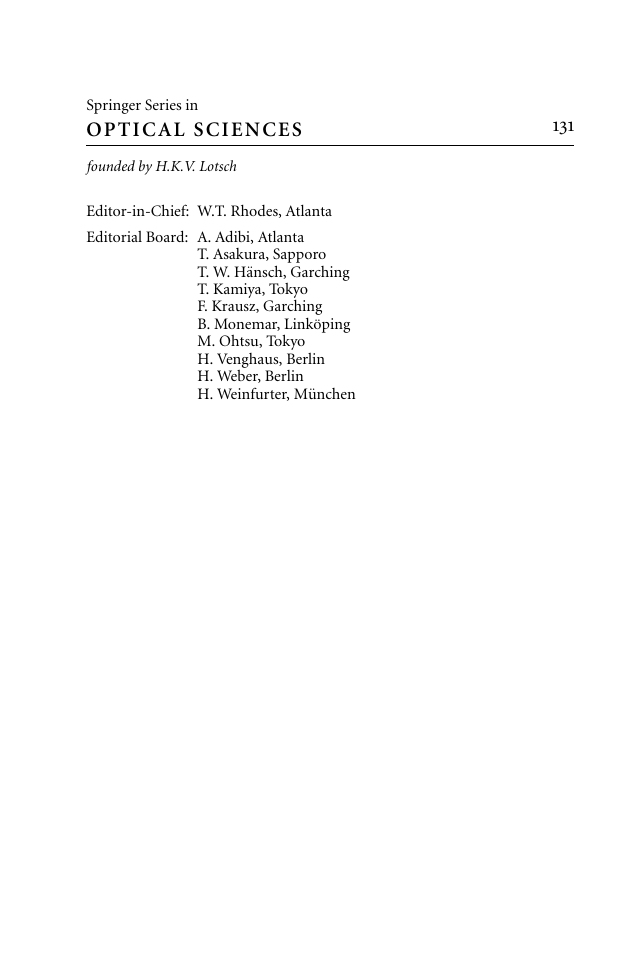
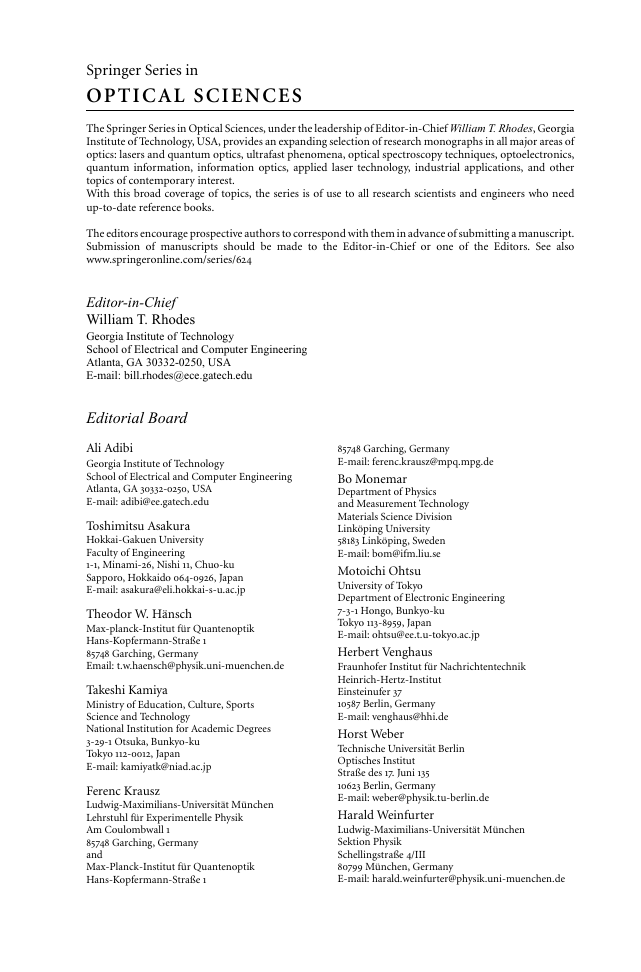
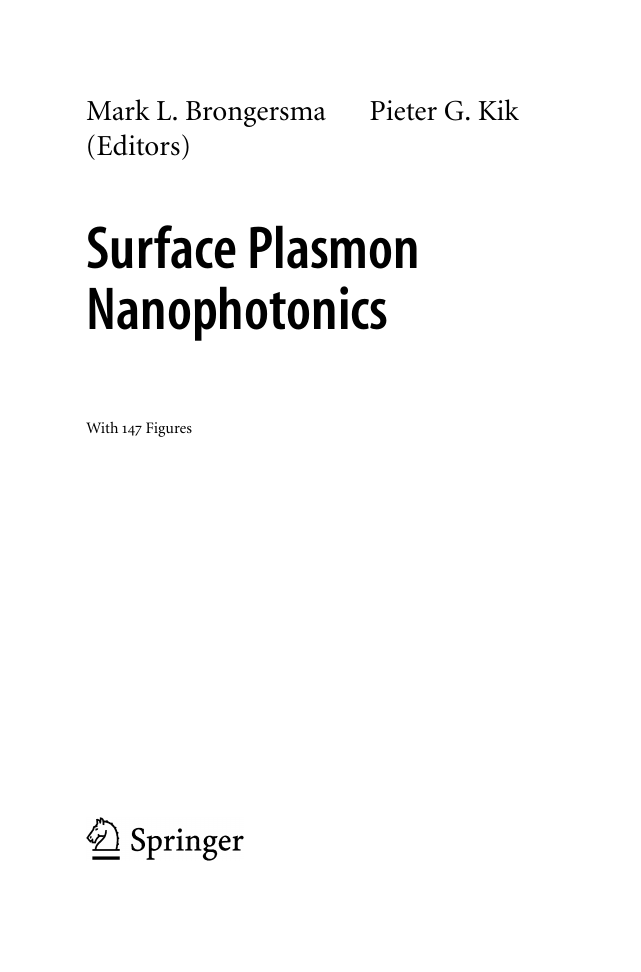

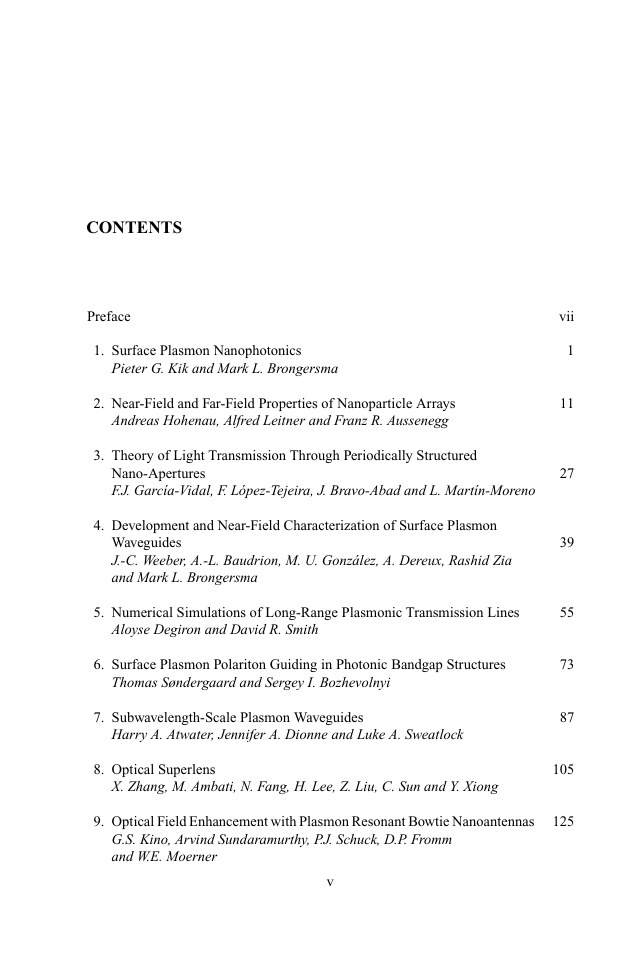
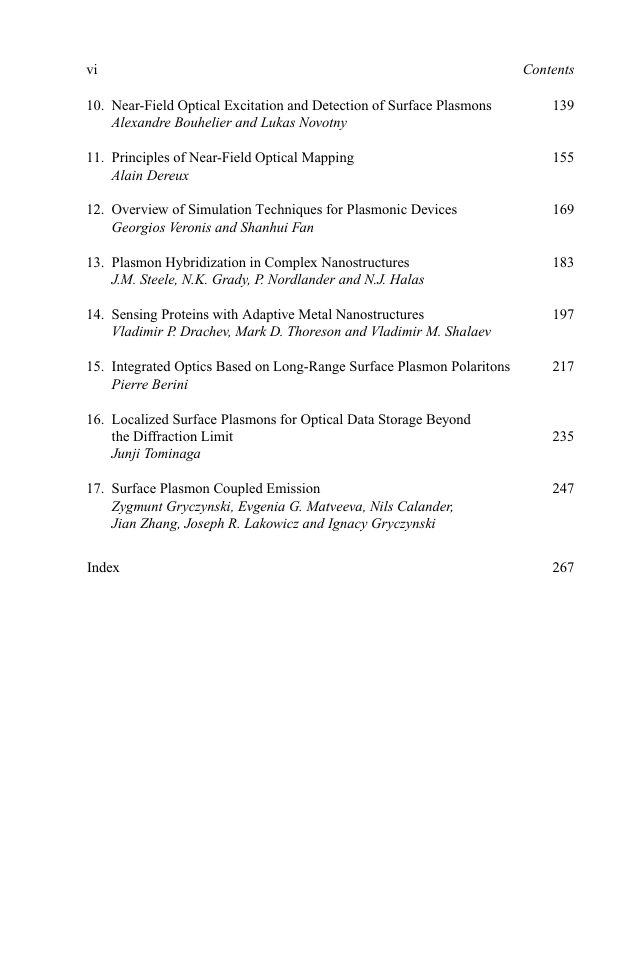
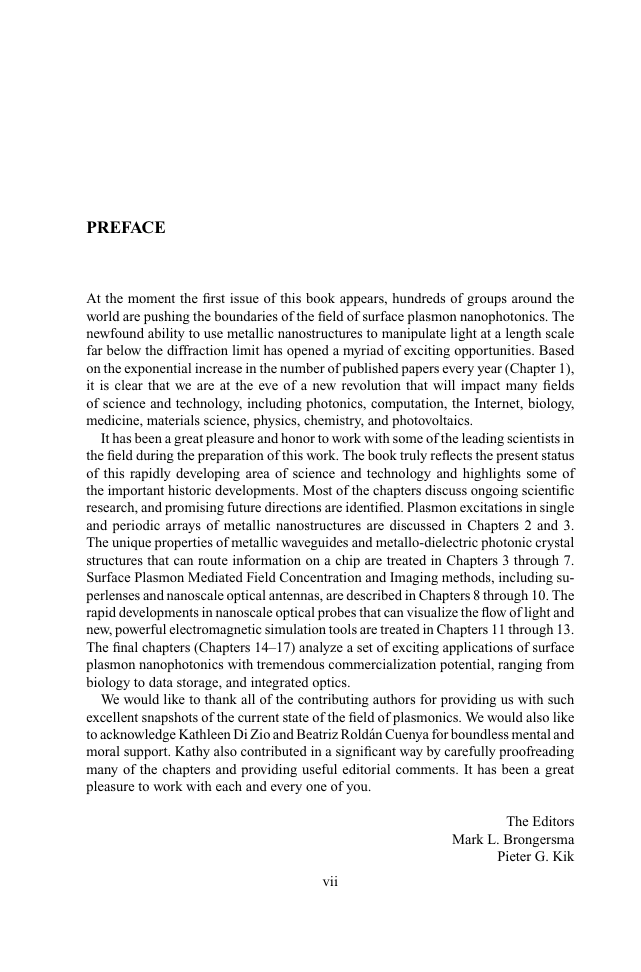
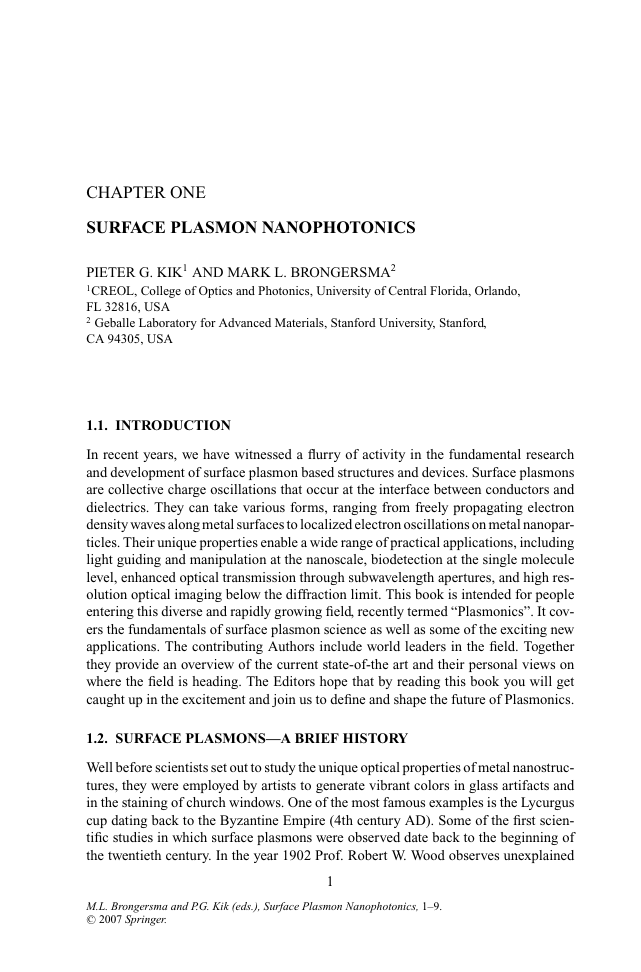








 2023年江西萍乡中考道德与法治真题及答案.doc
2023年江西萍乡中考道德与法治真题及答案.doc 2012年重庆南川中考生物真题及答案.doc
2012年重庆南川中考生物真题及答案.doc 2013年江西师范大学地理学综合及文艺理论基础考研真题.doc
2013年江西师范大学地理学综合及文艺理论基础考研真题.doc 2020年四川甘孜小升初语文真题及答案I卷.doc
2020年四川甘孜小升初语文真题及答案I卷.doc 2020年注册岩土工程师专业基础考试真题及答案.doc
2020年注册岩土工程师专业基础考试真题及答案.doc 2023-2024学年福建省厦门市九年级上学期数学月考试题及答案.doc
2023-2024学年福建省厦门市九年级上学期数学月考试题及答案.doc 2021-2022学年辽宁省沈阳市大东区九年级上学期语文期末试题及答案.doc
2021-2022学年辽宁省沈阳市大东区九年级上学期语文期末试题及答案.doc 2022-2023学年北京东城区初三第一学期物理期末试卷及答案.doc
2022-2023学年北京东城区初三第一学期物理期末试卷及答案.doc 2018上半年江西教师资格初中地理学科知识与教学能力真题及答案.doc
2018上半年江西教师资格初中地理学科知识与教学能力真题及答案.doc 2012年河北国家公务员申论考试真题及答案-省级.doc
2012年河北国家公务员申论考试真题及答案-省级.doc 2020-2021学年江苏省扬州市江都区邵樊片九年级上学期数学第一次质量检测试题及答案.doc
2020-2021学年江苏省扬州市江都区邵樊片九年级上学期数学第一次质量检测试题及答案.doc 2022下半年黑龙江教师资格证中学综合素质真题及答案.doc
2022下半年黑龙江教师资格证中学综合素质真题及答案.doc